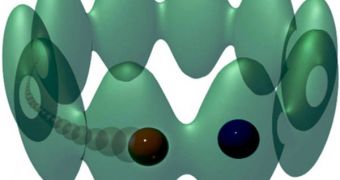Drawing inspiration from the classic spinning electric motor, theoretical physicists have proposed the construction of a full quantum-mechanic version of it, entirely made up of two atoms spinning incredibly fast in a ring of light. The weird thing about it is that researchers say it could be built at today's knowledge levels, but that, even then, scientists wouldn't have a full explanation of how it works. But, they add, the basic principle is roughly the same as in regular motors.
Reporting online in this week's edition of the prestigious journal Physical Review Letters, experts from the University of Augsburg, in Germany, describe the operating principle of the new construct. First of all, high-energy pulse lasers are required to fire in a pattern resembling a circle. Certain wavelengths from this light can trap two ultra-cold atoms, which have to be set in motion in order for the motor to spin. But this is the most difficult thing to do at a quantum level.
One of the two atoms, called the carrier, has one electron missing, which means that it's electrically charged. The research team, made up of Alexey Ponomarev, Peter Hanggi, and other colleagues, believes that, rather than applying an oscillating current in a coil, like in regular electric motors, they could apply an oscillating electric field perpendicular to the plane of the ring. But the ripples that such a current would cause in the laser light would stretch throughout the construct, which means that the atoms would virtually remain still.
In order to get the carrier going, the physicists have to use a starter atom – which does not miss any electrons, and therefore is not charged – that would make the carrier move when the two happen to be in the same light spot. However, unlike in electric motors, the electric field cannot simply be reversed. Scientists have to do so in a quantum manner, which means that the field, when reversed, will not be a mirror image of the straight one. Rather, some liken it to a song played normally and then backwards.
“Theoretically, it is very interesting; experimentally, there are some big questions as to whether it can be realized,” Max Planck Institute for the Physics of Complex Systems Physicist Sergej Flach, from Germany, says. “Of course, this [work] allows you to talk about motors. It's cute,” Technical University of Dresden Theorist Roland Ketzmerick adds, quoted by ScienceNow.

 14 DAY TRIAL //
14 DAY TRIAL //